Automotive gateway research: 10BASE-T1S and CAN-XL will bring more flexible gateway deployment solutions
ResearchInChina released "Automotive Gateway Industry Report, 2024", analyzing and researching impact of E/E architecture evolution on gateways, new gateways for passenger cars and commercial vehicles, gateway supplier analysis, gateway chip and gateway security software enterprise analysis.
1. Gateway presents different deployment strategies in the three stages of E/E architecture
As the hub of in-vehicle network, the deployment strategy of automotive gateway changes with evolution of E/E architecture.
In a distributed architecture, there is a traditional CAN gateway in the vehicle to connect electronic Control Units (ECUs) with different functions in the vehicle.
Under the domain control architecture, the gateway has two forms. One is to use a non-integrated central gateway to securely and reliably transfer data between multiple domains such as Telematics Control Unit (T-BOX), powertrain, body, infotainment system, digital cockpit and ADAS applications. The other is to use an integrated gateway, which integrates the central gateway into a domain controller. It can be divided into several forms, including integrated in central control domain, integrated in body domain, integrated in cockpit domain, integrated in communication domain, and integrated in intelligent computing domain. At this stage, the central gateway is usually a hybrid gateway of CAN + Ethernet.
Under Zonal architecture, the on-board computing platform is at the core of the computing, and Zonal controller mainly acts as a gateway, not only as a data processing center, but also as a power distribution module. Under this architecture, the zonal controller is more divided by physical location, which can further reduce ECU in the car, simplify cable layout and reduce cable length.
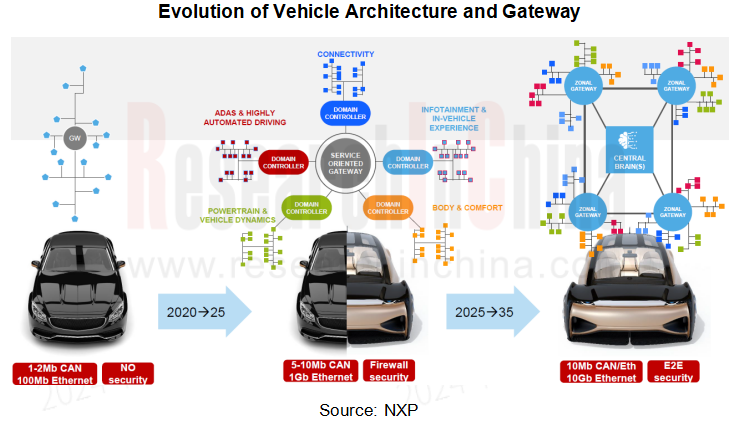
2. Deployment method of gateway under domain control architecture
In the domain control stage, there are four main deployment methods of? gateway, namely: an independent central gateway, a gateway integrated in vehicle control domain, a gateway integrated in cockpit domain, and a gateway centralized in central domain.
The independent central gateway is mainly responsible for communication between different domains, and Ethernet is used as backbone network to undertake information exchange tasks; the system interconnection within each domain still uses CAN and FlexRay communication buses. At this stage, the central gateway is usually a hybrid gateway of CAN + Ethernet.
The gateway integrated in vehicle control domain realizes integration of? central gateway with body control, chassis and even power.
The gateway integrated into cockpit domain supports wireless connection of the vehicle, provides remote interconnection functions, such as remote diagnosis, OTA updates, etc., and provides security services (intrusion detection, firewall, etc.). The intelligent gateway is one of the four key modules of the intelligent cockpit of the car.
In addition, the gateway also appears in the form of integration with the central domain control, such as Li L9.
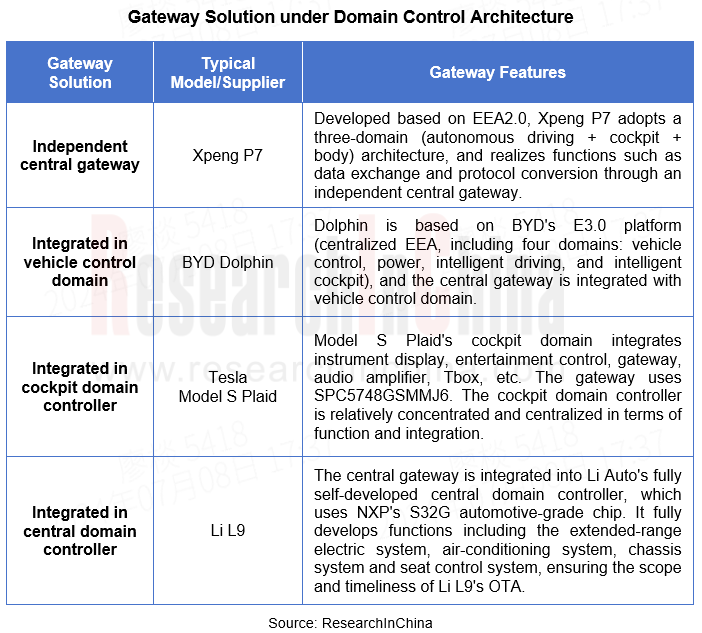
3. Zonal gateway under Zonal architecture will be gradually mass-produced from 2024 to 2025
Zonal architecture consists of a central brain and several zonal controllers, among which the central brain is mainly responsible for the complex data processing and calculation of the upper layer, and several zonal controllers are mainly responsible for functions of gateways, power distribution, data collection, and load control. Under Zonal architecture, there are mainly two kinds of gateways, one is integrated in central computing platform, and the other is integrated in zonal controller.
Under the general trend of software-defined vehicles, automotive E/E architectures require more flexible, personalized, and scalable network architectures, and the need for zonal control has become increasingly prominent. In 2024, a number of Zonal architecture models have been launched or will be launched soon, such as Chery STERRA ET, Changan Qiyuan E07, Neta Shanhai 2.0 models, etc.
?
Changan Qiyuan E07 is expected to be launched in October 2024. It adopts a "central + zonal" ring network architecture, composed of C2 (central computer) + EDC (experience computer) to form a central computing platform, plus three VIU (zonal controllers). It adopts ring network communication technology. The backbone is mainly 100-megabit Ethernet, and the core controllers are equipped with Gigabit network. The three VIU are responsible for network management and power distribution and control of nearby devices, and have realized cross-domain integration of 15 controllers for power, chassis, air conditioning thermal management, and body.?
In 2025, Neta Shanhai 2.0 platform model will be mass-produced and launched, which adopts the central controller and zonal controller solutions of HiRain, among which the central computing platform integrates the central gateway, body and comfort control, new energy vehicle power control, air conditioning and thermal management, vehicle management, full data collection, OTA upgrade, SOA services and many other functions; Zonal Control Unit has zonal gateway routing function, 100MB Ethernet, CAN-FD, LIN, etc.
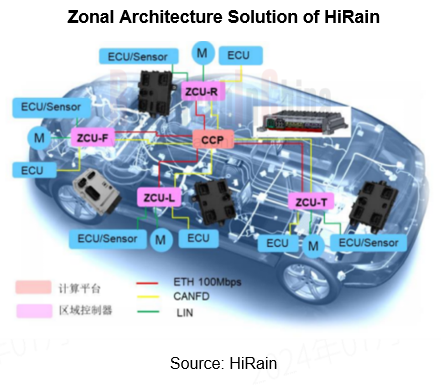
4 Ethernet 10BASE-T1S and CAN-XL will provide more flexible gateway deployment options
With faster transmission speeds and more stable communication connections, Ethernet is gradually becoming the backbone of in-car transmission. Xpeng G9, Voyah Zhuiguang, Lynk & Co 08, EXEED Yaoguang, IM LS7, Li L9, etc. are all equipped with Gigabit Ethernet, and GAC Aion's Xingling architecture even claims to use 10 Gigabit Ethernet data transmission.
In March 2024, BMW and ADI announced that they would be the first to adopt ADI's 10BASE-T1S E 2 B ? (Ethernet-Edge Bus) technology. Using ADI's 10BASE-T1S E 2 B technology, BMW eliminates microcontrollers and moves software from edge nodes to central processing units, thus enabling full hardware edge nodes and reducing software development and authentication tasks. That is to say, based on 10BASE-T1S E 2 B technology, traditional gateways will no longer be a required option.
?
While Ethernet quickly grabbed the market, CAN family welcomed the third generation member - CAN XL, and the performance was upgraded. The main advantages of CAN XL are:
1. High speed: CAN XL communication rate up to 20 Mbit/s, payload size increased to 2048 bytes, providing greater data throughput
2. Compatibility: On the one hand, it inherits the characteristics of CAN FD; and on the other hand, it has greatly expanded its protocol, allowing TCP/IP to run on CAN XL. It is expected to achieve good compatibility with Ethernet upper-layer protocols (especially service-oriented communication methods).
3. Cost-effective: Combining CAN and Ethernet functions while maintaining the low price of CAN.
?
In terms of standardization, ISO standardization work has begun to incorporate CAN XL into ISO standards ISO 11898-1 and ISO 11898-2, and CAN XL has also obtained AUTOSAR support. In terms of productization, Bosch and Daimler trucks use CAN XL networks instead of FD networks in the car for performance verification, and Infineon, NXP, STMicroelectronics, Renesas, etc. are also deploying CAN XL.
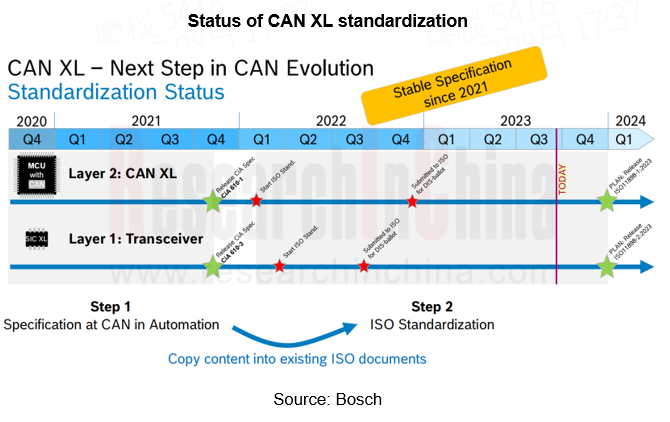
In short, 10BASE-T1S, which sank from high-speed communication technology, and CAN XL, which was upgraded from low-rate bus upgrades, are expected to "divide the world" in the 10 Mbit/s communication range, providing a more flexible solution for the future deployment of automotive communication networks, and will also have a practical impact on gateway requirements. After all, pure Ethernet architectures do not require gateways, while CAN-XL requires gateways to achieve protocol conversion.
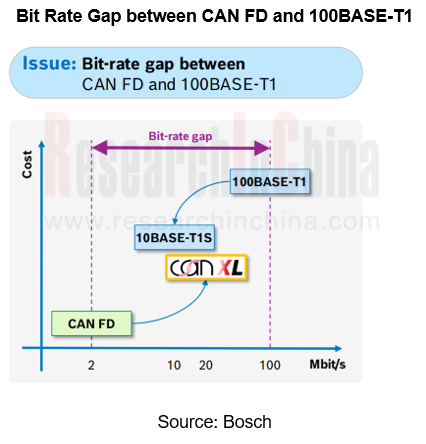
Autonomous Driving Domain Controller and Central Computing Unit (CCU) Industry Report, 2025
Research on Autonomous Driving Domain Controllers: Monthly Penetration Rate Exceeded 30% for the First Time, and 700T+ Ultrahigh-compute Domain Controller Products Are Rapidly Installed in Vehicles
L...
China Automotive Lighting and Ambient Lighting System Research Report, 2025
Automotive Lighting System Research: In 2025H1, Autonomous Driving System (ADS) Marker Lamps Saw an 11-Fold Year-on-Year Growth and the Installation Rate of Automotive LED Lighting Approached 90...
Ecological Domain and Automotive Hardware Expansion Research Report, 2025
ResearchInChina has released the Ecological Domain and Automotive Hardware Expansion Research Report, 2025, which delves into the application of various automotive extended hardware, supplier ecologic...
Automotive Seating Innovation Technology Trend Research Report, 2025
Automotive Seating Research: With Popularization of Comfort Functions, How to Properly "Stack Functions" for Seating?
This report studies the status quo of seating technologies and functions in aspe...
Research Report on Chinese Suppliers’ Overseas Layout of Intelligent Driving, 2025
Research on Overseas Layout of Intelligent Driving: There Are Multiple Challenges in Overseas Layout, and Light-Asset Cooperation with Foreign Suppliers Emerges as the Optimal Solution at Present
20...
High-Voltage Power Supply in New Energy Vehicle (BMS, BDU, Relay, Integrated Battery Box) Research Report, 2025
The high-voltage power supply system is a core component of new energy vehicles. The battery pack serves as the central energy source, with the capacity of power battery affecting the vehicle's range,...
Automotive Radio Frequency System-on-Chip (RF SoC) and Module Research Report, 2025
Automotive RF SoC Research: The Pace of Introducing "Nerve Endings" such as UWB, NTN Satellite Communication, NearLink, and WIFI into Intelligent Vehicles Quickens
RF SoC (Radio Frequency Syst...
Automotive Power Management ICs and Signal Chain Chips Industry Research Report, 2025
Analog chips are used to process continuous analog signals from the natural world, such as light, sound, electricity/magnetism, position/speed/acceleration, and temperature. They are mainly composed o...
Global and China Electronic Rearview Mirror Industry Report, 2025
Based on the installation location, electronic rearview mirrors can be divided into electronic interior rearview mirrors (i.e., streaming media rearview mirrors) and electronic exterior rearview mirro...
Intelligent Cockpit Tier 1 Supplier Research Report, 2025 (Chinese Companies)
Intelligent Cockpit Tier1 Suppliers Research: Emerging AI Cockpit Products Fuel Layout of Full-Scenario Cockpit Ecosystem
This report mainly analyzes the current layout, innovative products, and deve...
Next-generation Central and Zonal Communication Network Topology and Chip Industry Research Report, 2025
The automotive E/E architecture is evolving towards a "central computing + zonal control" architecture, where the central computing platform is responsible for high-computing-power tasks, and zonal co...
Vehicle-road-cloud Integration and C-V2X Industry Research Report, 2025
Vehicle-side C-V2X Application Scenarios: Transition from R16 to R17, Providing a Communication Base for High-level Autonomous Driving, with the C-V2X On-board Explosion Period Approaching
In 2024, t...
Intelligent Cockpit Patent Analysis Report, 2025
Patent Trend: Three Major Directions of Intelligent Cockpits in 2025
This report explores the development trends of cutting-edge intelligent cockpits from the perspective of patents. The research sco...
Smart Car Information Security (Cybersecurity and Data Security) Research Report, 2025
Research on Automotive Information Security: AI Fusion Intelligent Protection and Ecological Collaboration Ensure Cybersecurity and Data Security
At present, what are the security risks faced by inte...
New Energy Vehicle 800-1000V High-Voltage Architecture and Supply Chain Research Report, 2025
Research on 800-1000V Architecture: to be installed in over 7 million vehicles in 2030, marking the arrival of the era of full-domain high voltage and megawatt supercharging.
In 2025, the 800-1000V h...
Foreign Tier 1 ADAS Suppliers Industry Research Report 2025
Research on Overseas Tier 1 ADAS Suppliers: Three Paths for Foreign Enterprises to Transfer to NOA
Foreign Tier 1 ADAS suppliers are obviously lagging behind in the field of NOA.
In 2024, Aptiv (2.6...
VLA Large Model Applications in Automotive and Robotics Research Report, 2025
ResearchInChina releases "VLA Large Model Applications in Automotive and Robotics Research Report, 2025": The report summarizes and analyzes the technical origin, development stages, application cases...
OEMs’ Next-generation In-vehicle Infotainment (IVI) System Trends Report, 2025
ResearchInChina releases the "OEMs’ Next-generation In-vehicle Infotainment (IVI) System Trends Report, 2025", which sorts out iterative development context of mainstream automakers in terms of infota...